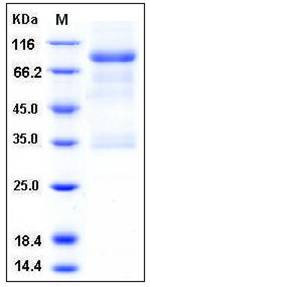Human GFRA3 / GFR-alpha-3 Protein (His & Fc Tag)
GDNFR3
- 100ug (NPP3891) Please inquiry
| Catalog Number | P10213-H03H |
|---|---|
| Organism Species | Human |
| Host | Human Cells |
| Synonyms | GDNFR3 |
| Molecular Weight | The recombinant human GFRa3/Fc is a disulfide-linked homodimeric protein. The reduced monomer consists of 599 amino acids and predicts a molecular mass of 67.3 kDa. As a result of glycosylation, the rh GFRa3/Fc monomer migrates as an approximately 80 kDa band in SDS-PAGE under reducing conditions. |
| predicted N | Asp 32 |
| SDS-PAGE |  |
| Purity | > 80 % as determined by SDS-PAGE |
| Protein Construction | A DNA sequence encoding the human GFRa3 (NP_001487.2) (Met 1-Trp 382) was fused with the C-terminal polyhistidine-tagged Fc region of human IgG1 at the C-terminus. |
| Bio-activity | Measured by its ability to bind mouse ARTN in a functional ELISA. |
| Research Area | Cancer |Invasion microenvironment |Angiogenesis |Cytokine & Receptor |Transforming Growth Factor Beta (TGF-beta) Superfamily |TGF-beta Superfamily Receptors | |
| Formulation | Lyophilized from sterile PBS, pH 7.5 1. Normally 5 % - 8 % trehalose, mannitol and 0.01% Tween80 are added as protectants before lyophilization. Specific concentrations are included in the hardcopy of COA. |
| Background | Glial cell line derived neurotrophic factor (GDNF) Family Receptor Alpha 3 (GFRA3) or GDNFRa3 is a member of the GDNF receptor family. It is a glycosylphosphatidylinositol (GPI)-linked cell surface receptor for both GDNF and NTN, and mediates activation of the RET tyrosine kinase receptor. GFRA3 / GDNFRa3 is a potent survival factor for central and peripheral neurons, and is essential for the development of kidneys and the enteric nervous system. Glial cell line-derived neurotrophic factor (GDNF) and neurturin (NTN) are its binding ligand which are two structurally related, potent neurotrophic factors that play key roles in the control of neuron survival and differentiation. GDNF promotes the formation of a physical complex between GFRA/GDNFRa and the orphan tyrosin kinase receptor Ret, thereby inducing its tyrosine phosphorylation. The RET is a receptor tyrosine kinase representing the signal-transducing molecule of a multisubunit surface receptor complex for the GDNF, in which GFRA / GDNFRa acts as the ligand-binding component. The neurotrophic growth factor artemin binds selectively to GDNF family receptor α3 (GFRA3 / GDNFRa3), forming a molecular complex with the co-receptor RET which mediates downstream signaling. This signaling pathway has been demonstrated to play an important role in the survival and maintenance of nociceptive sensory neurons and in the development of sympathetic neurons. |
| Reference |
